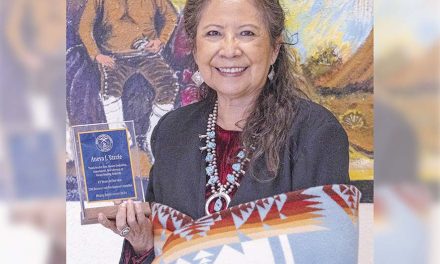
50 Years Ago: The highs and lows of the Fairchild operation in Shiprock
Officials for the Fairchild plant in Shiprock made the Navajo Times this week and in a good way.
Some 10 years before Fairchild would make news nationwide when members of the American Indian Movement took it over to protest unfair salary practices, Fairchild Semiconductor officials this week were praising the salaries the plant was offering.
A press release sent out by the company said payroll at the plant for the 325 people who worked there was approaching $1 million a year.
But the figures were a little misleading because the issues of pay that existed in 1966 were the same ones that caused the takeover in 1975.
Greg Harrison, the plant manager, said 50 years ago that the plant was going strong and was looking at increasing employment to as many as 600 within the next year. It would get as high as 1,000 in the early 1970s.
He said that 22 families had purchased homes in the Farmington area as a result of the plant’s activities over the past year and the work that employees have done in the assembly of high performance silicon transistors has created a need for “many more employees.”
“A one-million dollar a year payroll generally creates an economic impact of about $4 million for the community,” said Harrison.
But although the operation, which at first was housed in the high school gymnasium until the plant was built by the tribe in 1969, is located in Shiprock, the economic impact he was talking about was in Farmington since Shiprock still had few businesses and people traveled to Farmington for most of their basic needs.
Still, Shiprock is benefitting, Harrison said, because most of the employees are from that area and the town is “well on its way toward becoming the industrial center envisioned by the Navajo Tribal Council when they approved our location on the reservation,” Harrison said.
The plant next month will celebrate its one-year anniversary and Harrison talked about the training program, which was in effect to teach Navajos how to make the semi-conductors quickly and efficiently.
That training program was the secret of the plant’s financial success because while the payroll may have been close to $1 million, all of the high salaries were going to non-Navajo employees of the plant.
Navajos were only being trained for the assembly line and in 1966, there were no provisions in the lease agreement with the tribe to start training to fill some of these high paying positions. That would come in the 1970s when then chairman Peter MacDonald and Tom Brose, head of the tribe’s labor department, began putting pressure on the company to start putting Navajos in at least the middle management positions.
The thing that was brought out by the AIM takeover in February 1975, was that the company wasn’t even paying many Navajos workers minimum wage because they had a contract through the tribe to get training funds and while the employee was being trained, the company had to pay only half of their salary and the tribe, through a federal training grant, would pay the other half.
AIM officials charged that the company was violating the training agreement by laying off Navajos a short time after their training period ended so they could hire someone new and put them in the training program and save the full cost of their salary.
By the 1970s, this practice would come under scrutiny by the tribe and the federal government and Fairchild officials would be put on notice that they would have to start complying with the law and keeping people on after the training period was over.
There were also charges that the plant leadership did not respect Navajos and called them names in private and really didn’t appreciate the long hours they were working to make the company a profit.
This is when 20 armed protestors belonging to AIM stepped in, took over the plant (with armed guards patrolling the rooftops) and demanding that Navajo workers get a fair deal or they would either burn down the plant or blow it up.
Of course, this didn’t make a lot of sense since the building was owned by the Navajo Tribe and Fairchild was just leasing it but AIM officials were expecting that Fairchild would cave in because they were making so much money.
That was a good theory but what AIM didn’t know was that Fairchild had been thinking of moving the plant operations overseas to Asia where labor costs were a lot cheaper and no one bothered to look at the details of the labor agreements.
Once the takeover ended – peacefully – after eight days, Fairchild speeded up plans and moved out to set up its operations elsewhere leaving the building vacant for several years while the tribe searched for a new tenant.
AIM was criticized by many in the Shiprock area for its role in the closing of the plant with Navajo workers upset that their jobs had been lost.
But what was lost in all of this rhetoric was the fact that Fairchild’s days at running the Shiprock plant were numbered because of efforts by the tribe to get fairer treatment to the workers and more Navajos in high paying positions, both of which would have been opposed by the management at the plant.
Another factor in all of this was that the American nation was in an economic slump, caused by a recession that began in 1974 and caused the company to lay off more than 100 Navajo employees in 1975.
What the takeover did was give the company an excuse to get out of its lease, and the takeover would also cause tribal officials a lot of grief because any company that considered moving into the plant had to worry about another intervention by AIM if their company policies were to be considered to be unfair to Navajo employees.
Another thing that should be pointed out is the fact that the semi-conductors assembled at the Fairchild Plant helped spawn the growing personal computer industry and the Navajo workers received a lot of good publicity about the work they were doing.
National Geographic, a magazine more noted for its articles on foreign countries and the exploration of the unexplored regions of the world, did a major story on the workers and praised them for their ability to assemble the semiconductors, saying that their years of working on rugs and jewelry gave them the experience they needed to make this happen.
To read the full article, pick up your copy of the Navajo Times at your nearest newsstand Thursday mornings!
Are you a digital subscriber? Read the most recent three weeks of stories by logging in to your online account.







 Highway 264,
Highway 264, I-40, WB @ Winslow
I-40, WB @ Winslow